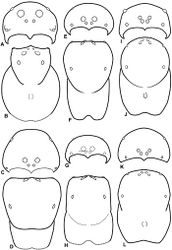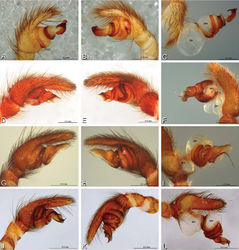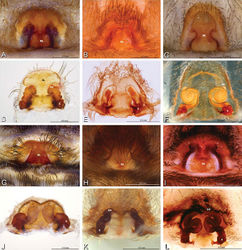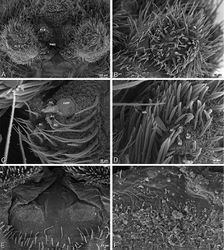Seothyra henscheli
| Notice: | This page is derived from the original publication listed below, whose author(s) should always be credited. Further contributors may edit and improve the content of this page and, consequently, need to be credited as well (see page history). Any assessment of factual correctness requires a careful review of the original article as well as of subsequent contributions.
If you are uncertain whether your planned contribution is correct or not, we suggest that you use the associated discussion page instead of editing the page directly. This page should be cited as follows (rationale):
Citation formats to copy and paste
BibTeX: @article{Miller2012ZooKeys195, RIS/ Endnote: TY - JOUR Wikipedia/ Citizendium: <ref name="Miller2012ZooKeys195">{{Citation See also the citation download page at the journal. |
Ordo: Araneae
Familia: Eresidae
Genus: Seothyra
Name
Seothyra henscheli Dippenaar-Schoeman – Wikispecies link – Pensoft Profile
- Seothyra henscheli Dippenaar-Schoeman, 1991: 156, figs 15, 26, 37, 67–70.
Description
Male (Gobabeb Station, Namibia, SMN 40828, NMN): Carapace without conspicuous white setae; cephalic region subrectangular, longer than wide, strongly raised; AME slightly larger than PME (AME/PME 1.08), median eyes adjacent on horizontal axis, some overlap on vertical axis; ALE tubercles absent; PER slightly wider than AER (PER/AER 1.18), PLE position on carapace 0.35; clypeal hood forms a slightly less than 90° angle; fovea deep. Chelicerae with small lateral boss, excavated mesally, with tooth bearing a row of four denticles adjacent to the base of the fang. Legs without conspicuous white setae; femur, patella and tibia I conspicuously thickened; with row of distal ventral macrosetae on metatarsus II–IV plus a distal ventral macroseta on tibia III and scattered ventral macrosetae on metatarsus and tarsus III–IV and tibia IV. Abdomen with many white setae dorsally (Fig. 72A–D).
Male palp with proximal-distal axis; tegulum bulbous; conductor and embolus together form apical complex making about two helical turns; conductor increasingly sclerotized distally terminating in a recurved hook; embolic division longer than tegular division; cymbium with several prolateral and retrolateral macrosetae, some macrosetae arising from retrolateral modified with subbasal enlargement (Figs 15A–C, 72I, J, 73A–F).
Female (Gobabeb, Namibia, SMN 46627, NMN): Carapace with many stiff dark setae in the cephalic region and scattered white setae, especially in the thoracic region; cephalic region subrectangular, longer than wide, moderately raised; AME slightly larger than PME (AME/PME 1.05), median eyes adjacent on horizontal axis, some overlap on vertical axis; ALE tubercles absent; PER slightly wider than AER (PER/AER 1.09), PLE position on carapace 0.38; clypeal hood forms a slightly obtuse angle; fovea moderately deep. Chelicerae contiguous mesally, with small lateral boss. Legs without conspicuous white setae; legs with row of distal ventral macrosetae on metatarsus II–IV, a few scattered ventral macrosetae on tarsus II and numerous ventral macrosetae on metatarsus and tarsus III–IV. Abdomen with white setae mostly around the margin (Figs 72E–H, 75A, B).
Epigynum with sinuous slit-like atria occupying ca. half the total length, median lobe margin defined anteriorly and laterally by a ridge (Figs 18G, 76A). Vulva with tightly-wound sinuous stalk leading to spermathecal head at anterior end, multilobed spermathecae at posterior end (Figs 18F, 76B–D).
Spinneret spigot morphology
Female ALS with spinning field of more than 50 PI (Figs 75E, 77B), male with more than 30 PI (Fig. 78B); both sexes lack MAP on ALS. Female PMS with 2 anterior mAP spigots, a large posteromedian spigot (probably CY), and 8 smaller spigots (Fig. 77C); male PMS with 1 central mAP and 3 AC (Fig. 78C). Female PLS with anterobasal MS and 2 accompanying spigots and distal field of more than 35 AC (Figs 75F, 77D); male MS with 2 flanking nubbins, and only 3–4 AC (Figs 74B, 78D); male and female PLS with peculiar, large, clavate lateral setae. Male cribellar plate with no sign of spigots (Fig. 78E, F); numerous epiandrous gland spigots present (Fig. 74C, D).
Taxon Treatment
- Miller, J; Griswold, C; Scharff, N; Řezáč, M; Szűts, T; Marhabaie, M; 2012: The velvet spiders: an atlas of the Eresidae (Arachnida, Araneae) ZooKeys, 195: 1-144. doi
Images
|









